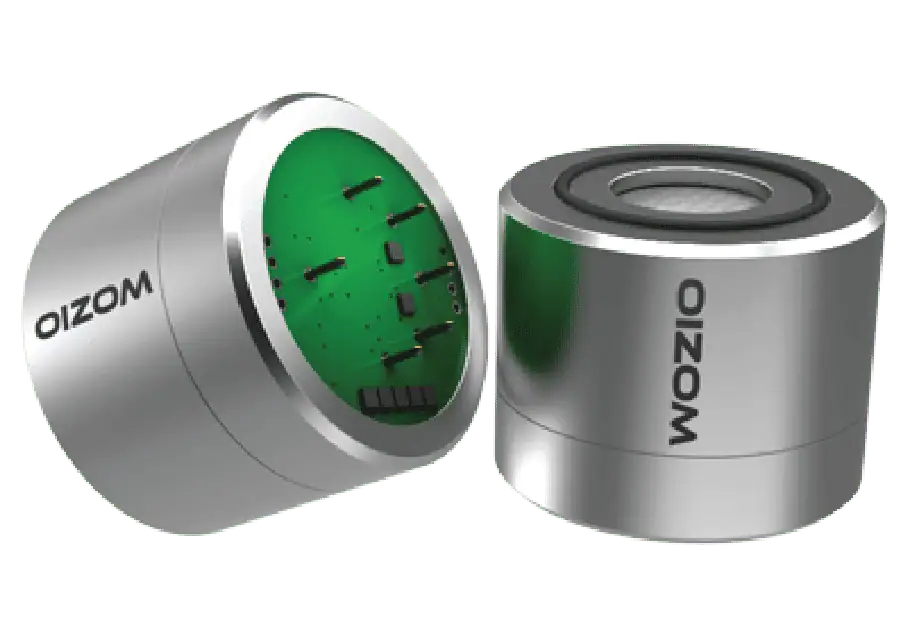
Hydrogen Chloride (HCl) Sensor
Advanced Hydrogen Chloride Monitoring Sensor for Real-time Emission Monitoring
Hydrogen Chloride (HCl) is a colorless gas with a sharp, irritating smell. It is made up of one hydrogen atom and one chlorine atom. When HCl gas dissolves in water, it forms hydrochloric acid, which is highly corrosive. Monitoring HCl levels in the air is important for worker safety in industrial zones, corrosion control for sensitive equipment, and regulatory compliance with air quality standards. Oizom’s HCl sensor offers real-time monitoring with high precision, even at low concentrations. Designed for harsh conditions, it supports preventive maintenance, helps meet regulatory standards, and ensures worker safety. Whether it’s for chemical plants, waste incinerators, or refineries, this sensor integrates easily into our fixed and mobile air quality monitoring systems.
Oizom’s Hydrogen Chloride (HCl) sensor uses electrochemical sensing, where HCl gas reacts with the sensor’s electrode surface to produce a small electric current. This current is directly proportional to the concentration of HCl in the air, enabling precise and real-time measurement. With a nominal detection range, the sensor is ideal for tracking emissions in industrial setups like chemical plants and waste treatment facilities. Its compact design, low drift, and selective measurement help ensure consistent performance across varying environmental conditions.
Oizom’s Hydrogen Chloride (HCl) monitoring sensor is designed using the OGS (Oizom Gas Sensor) architecture, which ensures long-term stability, precise measurements, and rugged performance in industrial environments. The sensor provides reliable Hydrogen Chloride data in the environment for applications like emission monitoring in chemical plants, waste treatment units, and industrial zones. The sensor also shows minimal drift, ensuring consistent readings over extended periods.
The OGS design focuses on high selectivity, minimal cross-sensitivity, and compact, durable housing. It ensures optimal airflow and consistent sensor stability in varying environmental conditions. This makes the sensor ideal for both fixed installations and mobile deployments, and it integrates smoothly into Oizom’s air quality monitoring solutions to support compliance, safety, and process efficiency.
The Oizom HCl sensor is lab-calibrated, ensuring accurate baseline readings from the moment it’s deployed. This initial calibration aligns the sensor’s output with known reference standards for reliable performance in diverse environments. To maintain accuracy over time, the sensor supports manual field calibration using certified gas cylinders. This step is especially useful for correcting any drift caused by environmental changes or exposure to site-specific gas mixtures. The sensor is also calibrated through colocation calibration, where it is temporarily installed alongside a reference-grade analyzer. This side-by-side setup helps fine-tune the sensor’s output by comparing it with highly accurate instruments under actual site conditions.
Periodic recalibration, whether through gas calibration or colocation, is essential for maintaining performance, especially in high-exposure or changing environments. This flexible approach ensures the sensor continues to deliver precise, trustworthy data over time.
OZHCl_1
Range (ppm): 0-50
Resolution (ppm): 0.5
Min. Det.(ppm): 0.5
Drift: < 2% / Month
Sensor Life: 2 Years
OZHCl_2
Range (ppm): 0-100
Resolution (ppm): 1
Min. Det.(ppm): 1
Drift: < 2% / Month
Sensor Life: 2 Years
Chemical Manufacturing
In chemical manufacturing, Hydrogen Chloride is commonly used in production and storage processes. Monitoring its concentration is essential for worker safety and maintaining air quality standards. HCl monitor provides real-time data, helping plant managers detect leaks early and stay compliant with environmental regulations.
Waste Incineration Plants
At waste incineration plants, HCl can be released when burning materials containing chlorine. Continuous Ambient Air Quality Monitoring(CAAQM) systems equipped with Oizom’s HCl monitoring sensors allow operators to measure these emissions accurately. This data is critical for reporting and for keeping emissions within legal limits.
Petrochemical and Oil Refineries
In petrochemical and oil refineries, Hydrogen Chloride may be present in various processing units. The sensor plays a key role in detecting acid gas leaks and monitoring process emissions. This supports preventive maintenance and reduces the risk of corrosion-related failures or hazardous exposure.
Pulp and Paper Industry
The pulp and paper industry also benefits from HCl monitoring, especially in areas where bleaching agents or chemical recovery systems are used. These processes can release acidic gases, so having an HCl sensor in place helps protect both equipment and personnel while keeping production compliant with air quality norms.
Fertilizer Plants
Fertilizer plants involve chemical reactions where acidic compounds are often released. Monitoring HCl during acidification or granulation helps operators maintain safe working conditions and avoid equipment degradation. The sensor’s precision ensures timely alerts and reduces long-term maintenance costs.
Looking for Air Quality Monitoring Solution for your Project?
Schedule a call with our team of experts and get a customised solution for your air quality monitoring requirement.
Frequently Asked Questions (FAQs)
BTEX stands for Benzene, Toluene, Ethylbenzene, and Xylene, common volatile organic compounds found in industrial emissions and fuels.
These compounds are toxic and harmful to human health. Monitoring helps detect exposure early and ensures compliance with safety regulations.
It uses a photoionization detector (PID) that ionizes VOCs with UV light and measures the resulting electric signal.
It delivers 90% of the reading in less than 2 minutes, making it ideal for real-time monitoring.
Oizom’s sensor combines high sensitivity with rugged design. It delivers real-time data, is easy to integrate, and works reliably in extreme outdoor conditions, ideal for both industrial and ambient monitoring.
Yes, it’s built with a durable body and works well in extreme temperatures and high humidity.
The sensor is enclosed in a weather-resistant stainless steel housing. While it’s designed for outdoor use, proper housing or enclosures are recommended for long-term exposure to rain or direct splash.


